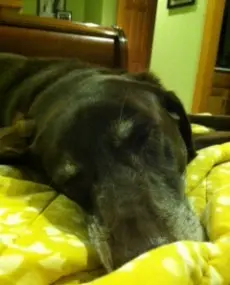By Dr. Regehr (original release 8/2013)
Molly doesn’t worry about hip dysplasia, but I do.
Is there anything that strikes more fear in the veterinarian’s mind than the discussion of orthopedic issues like Hip Dysplasia? Aside from itchy skin, probably not. Why is that? With all orthopedic (bone and muscle) issues we have two problems that need to be managed. We have to first treat the current problem and for your pet that may be limping or pain. We also have to plan for long term prevention of further joint injury to prevent chronic pain and joint change (arthritis). Hip Dysplasia and arthritis are not the same disease. Arthritis has many names which include Degenerative Joint Disease and Osteoarthritis. Arthritis is stable or ongoing inflammation of one more joints. It occurs when there is injury to a joint or the joint was not developed perfectly as a result of genetics.
See there? The definition of arthritis took a whole paragraph. We haven’t even discussed what hip dysplasia is yet, but the back story is so important. I LOVE education and think it is a big part of my end of the bargain when it comes to having a functioning relationship with you and your pet. However, when it comes to joint health issues there is so much information that I worry about “info overload, ” yet each part is critical to assure your pet a long and comfortable life.
Okay, let’s move on to hip dysplasia. Hip dysplasia is not arthritis, but arthritis will develop in every dog as a result of being born with hip dysplasia. Dogs do not “get” hip dysplasia when they are old. They get it from their parents. Adults with bad hips with pass that on to their puppies. Two problems can occur together or apart in the hip (coxofemoral) joint. Either the ball of the femur (thigh bone) does not fit well under the cup (acetabulum) of the hip, or the hip joint is so loose that the femur bangs around in the socket. Both of these can also happen at the same time.
Now we know that dogs are born with hip dysplasia but develop arthritis over time. Are all puppies with hip dysplasia painful? Some are and some are not. It is dependent on the severity of the above two problems. What is guaranteed is that all dogs born with it are actively damaging cartilage which leads to painful arthritis.
How do we find out if your dog has a problem? Most importantly, we take a thorough history and perform a physical exam. We also recommend hip screening films (x-rays) for all dogs at their spay, neuter or first sedation procedure here. We might recommend them annually in dogs that are identified with problems. These X-rays require sedation or anesthesia for appropriate positioning. Accurate hip films can not be taken on awake animals. Pelvic films may be taken for certain reasons awake, but for hip screening they are never appropriate awake.
So, how do we prevent pain and lameness if you didn’t even know your pet has a problem? Once we’ve identified Hip Dysplasia we will make recommendations about prevention. Remember, we can’t prevent arthritis, but we can slow your pet’s clinical signs and the progression of this disease. We address all the following areas: weight, exercise, diet (fatty acid intake), joint inflammation and a need for supplements.
With young active dogs having no signs of pain we do this by diet change to Hill’s J/D diet (therapuetic joint health diet), exercise and weight control. We might also recommend Adequan injections which heal joint cartilage microscopically.
Now, what about middle age to older dogs? If your dog is slow to get up, gimps along after the first few steps after sleeping/laying, walks with a left side to right side wobbling gate or bunny hops with the back legs, he or she is painful. Getting older is not a cause for these behaviors. Age is not a disease. Arthritis is a disease and it is painful. Pain needs to be treated.
That is so important for all dogs that it bears repeating! If your dog does any of those things he or she is painful regardless of age. Read the rest of the article then come back and watch this video about hip dysplasia. Most importantly watch how the dogs in the video are walking. Does your pet do this?
These dogs will have the same recommendations as the young dogs along with pain and anti-inflammatory medications. Other things that we can facilitate are physical therapy, customized exercise plans, acupuncture, laser therapy, stem-cell therapy and neutraceuticals. The critical message is that we must slow further damage and alleviate pain.
Okay, so I am bringing all this confusion back around to my dogs as an example. Molly (age 11 1/2) was diagnosed with mild hip dysplasia when young and has moderate arthritic changes now with severe clinical signs at home (altered gait, slow to rise, bunny hopping on stairs). Conversely, Idabelle (age 2) has severe hip dysplasia with no clinical signs. Idabelle’s hip dysplasia is so severe that one of her femurs (thigh bone) is almost out of the socket. The importance here is that most young dogs have no idea their hips are malformed, but they are doing damage daily in their normal lives that will develop into pain later.
This is why you will so often here us recommend the Hill’s J/D diet with it’s high doses of fish based fatty acids. Fatty acids are the only nutritional supplement shown to improve joint health based on research studies. This along with Adequan are the only available non-invasive treatments for healing cartilage.
Yep, it took all that just to explain the maintenance care for dysplastic and arthritic dogs. There are surgical options for the treatment of hip dysplasia as well. However, in twelve years of practice Dr. Ferrell and I have never referred a patient have total hip replacement surgery. We have had countless patients with hip dysplasia and arthritis. If you see that your pet is having trouble getting up and down, is slow on the stairs or slow to get going, pain is present. Please call and we will help get your pet more comfortable.



Leave a Reply
You must be logged in to post a comment.